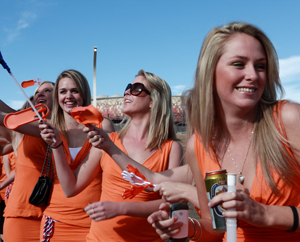National euphoria: how ambush marketing succeeds in sport – and its legal pitfalls
June 5, 2024
Every brand and its dog will want to take advantage of the packed sporting summer. David Granger, director of Arc & Foundry Creative looks at the upsides and potential downsides of following the hype.
There’s an excellent advert for soft drink Irn-Bru doing the social rounds which declares an unusual state of uncontrolled optimism in Scotland. It features a Scot and a German discussing the national side or mannschaft as they’d say in Munich, Berlin or Hamburg. It doesn’t mention a football tournament, but clearly it’s an allusion to the match scheduled for June 14, the opening game of Euros 24. (Barr, the manufacturer mention the Euros in its PR.)
It’s a fair way away from the strict restrictions which are supposedly in place, and arguably, despite being a great piece of marketing, does devalue official partners’ and sponsors’ investment. Back in the day, the Red Bull Arena in Salzburg had to temporarily remove all the spectator seating which coloured the Red Bull logo because the Euros 2008, co-hosted by Austria and Germany, was sponsored by, well… a rival drinks firm which (ironically) had red as its main brand colour.
We also had a very (very) strict blackout during any IOC event to ensure Red Bull athletes, ambassadors and their content were not seen in any way to conflict with the four-yearly games. And we had a brilliant – but strict and frankly terrifying – chief counsel ensure we stuck to the letter and the spirit of those restrictions.
People have been trying it on for years though. Who can forget the orange dresses of the Bavarian Beer-backed ladies at the Netherlands v Denmark game in the 2010 World Cup? Or the customised Beats headphones worn by athletes at the 2012 Olympics in London? Or when Puma had giant inflatables made of their v1.06 football boots during the 2006 World Cup placed around Germany? Well, perhaps not the last one, but it still kicked up a fuss. FIFA issued warnings and tightened both monitoring and enforcement. As they did in 2010 which led to some debate over whether they were being slightly over-bearing on Bavarian Beer ladies in the orange dresses
Fast forward to 2024 and there are websites upon blogs upon websites upon LinkedIn thought-leadership pieces outlining the “marketing opportunities” for non-official sponsors.
This opportunity/propensity to flout the regulations is partly, if not wholly down to the way media has changed, even since 2010. You don’t need to get all dressed up in orange to guerilla your way on to people’s screens. There will be a rash of social campaigns which take advantage of the hope, euphoria and, yes, uncontrolled optimism running through the fans’ veins this summer.
The flip side is two-fold. Firstly, as mentioned it does devalue to a certain extent the investment from the official partners and sponsors, but secondly there is a massive potential for legal action against those who blatantly decide to hijack the bandwagon.
One of the best descriptions of how the legal case works is provided by global law firm Taylor Wessing. In a post which should be read by every marketing manager, partnership manager and sporting federation, they outline how ambush marketing is done by either association or intrusion. The first, association, is “a coordinated attempt by a brand to associate itself, directly or indirectly, with a major event and/or its participants, as a marketing strategy, without permission.” Intrusion is “direct marketing within official events themselves, without prior authorisation” like the Bavarian Beer ladies.
And the fines for brands caught out are not insignificant.
So… the laws still stand, the risks are still being taken by brands, but the rewards to piggy-back a nation’s success on the sports field remain. And on occasion, it makes for great marketing, as well as potential future legal case studies. In the meantime, enjoy the Irn-Bru advert and their celebration of uncontrolled Scottish optimism:

